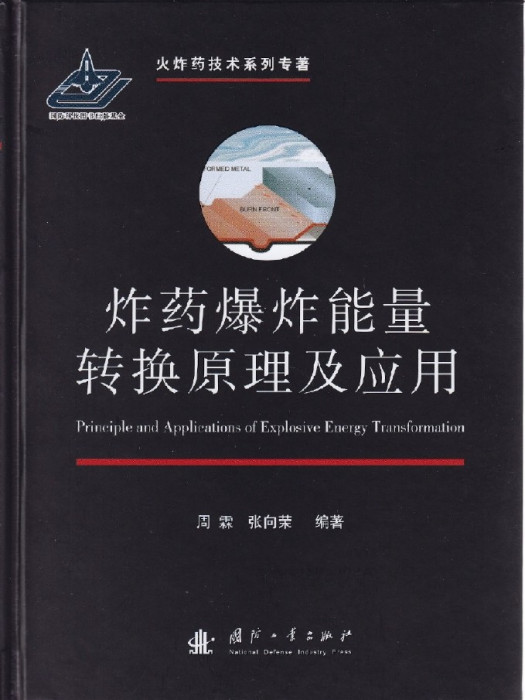《炸藥爆炸後能量轉換原理及套用》是2015年1月國防工業出版社出版的圖書,作者是周霖。
基本介紹
- 中文名:炸藥爆炸後能量轉換原理及套用
- 作者:周霖
- 出版時間:2015年1月
- 出版社:國防工業出版社
- 頁數:289 頁
- ISBN:9787118098754
- 定價:88.00
- 開本:16 開
- 裝幀:精裝
- 字數:349
- 叢書名:火炸藥技術系列專著
內容簡介,圖書目錄,英文目錄,
內容簡介
本書以炸藥爆炸能量為對象,探討了炸藥爆炸能量轉換的原理,總結了爆炸能量轉換的若干實際套用情況。本書前兩章將介紹炸藥的通性及炸藥爆炸能量及做功能力的評估原理與方法;第三章則闡述炸藥爆轟波的傳播特性及爆轟參數的計算方法,以作為後續幾章有關爆炸能量轉換技術套用內容的理論鋪墊。
在第四章將側重闡述利用爆炸效應加速飛片和粒子達到高速或超高速的技術及原理,以及進而造成高壓狀態的原理及其套用;第五章和第六章則著重介紹爆炸能量實施對金屬和固體的加工、成形、焊接與大面積複合,以及壓實燒結等方面的技術及其原理等;在第七章則介紹利用爆炸與衝擊作用實現物質相變的基本理論以及利用爆炸合成新材料,特別是爆炸合成超硬材料的相關技術;在本書的第八章將較系統而簡要地闡述利用爆炸能量轉換技術造成的超強磁場和兆安培脈衝大電流的爆炸磁壓縮發生器的原理與技術,並展望這一技術的套用前景。
圖書目錄
第1章炸藥及其通性
1.1炸藥及其化學變化的形式
1.2炸藥爆炸的基本特徵
1.3簡論爆炸科學技術發展與套用
第2章炸藥能量的熱化學評估
2.1引言
2.2燃燒與爆炸化學熱力學基礎
2.2.1濃度、化學計量關係
2.2.2狀態函式及熱力學關係
2.2.3狀態方程
2.2.4燃燒與爆炸產物化學平衡
2.2.5燃燒與爆炸產物組成、熱力學性質的計算
2.3炸藥爆炸的熱效應
2.3.1炸藥爆熱評估
2.3.2爆熱的實驗測量
2.3.3炸藥的爆溫
第3章炸藥爆轟動力學簡論
3.1穩定爆轟波的C-J假說
3.1.1爆轟波穩定傳播的條件——C-J條件
3.1.2凝聚炸藥爆轟參數的近似計算
3.2爆轟波的Z-N-D模型及波區內的參數分布
3.2.1爆轟波的Z-N-D模型
3.2.2爆轟波反應區流動的定常解
3.2.3凝聚炸藥爆轟反應的結構
3.3爆轟波參數的工程計算及實驗測量
3.3.1爆速及爆轟壓強工程計算方法
3.3.2凝聚炸藥爆速的實驗測定
3.3.3爆轟波C-J壓力的實驗測量
3.4炸藥爆炸產物對介質的直接作用
3.4.1爆轟產物的平面一維膨脹運動
3.4.2有限長度藥柱爆轟產物的一維流動
3.4.3爆轟產物對剛壁面的作用衝量
3.5爆炸對可壓縮固體的作用
3.5.1爆炸初始衝擊波壓力的計算
3.5.2高速碰撞壓力的計算
3.5.3分界面運動規律及爆炸比衝量的近似解
第4章利用爆炸獲得超高速
4.1炸藥對剛性活塞的一維拋射
4.2可獲得宇宙速度的炸藥炮技術及其驅動理論
4.3氣炮載入條件下炸藥強爆轟驅動技術
第5章金屬的爆炸加工與成型
5.1水中爆炸成型理論及套用
5.1.1水中爆炸現象及衝擊參數的評估
5.1.2爆炸成型機理和鄭氏爆炸成型理論
5.1.3鄭氏爆炸成型模型律
5.1.4爆炸成型的若干事例
5.2爆炸對金屬的切割
5.2.1爆炸切割裝藥參數及切割厚度的確定
5.2.2爆炸切割技術概述
5.3爆炸壓紋、雕刻及其他
第6章爆炸焊接(複合)、壓實與燒結
6.1平板的爆炸複合焊接
6.1.1平面複合焊接的構形及設定
6.1.2爆炸焊接機理概述
6.1.3爆炸焊接參數及確定方法
6.1.4爆炸焊接的其他套用
6.2粉末的爆炸壓實與燒結
6.2.1爆炸壓實與燒結方法
6.2.2爆炸壓實與燒結機理
第7章固體的衝擊相變與新材料的爆炸合成
7.1固體的衝擊相變
7.2利用衝擊波測量研究衝擊相變現象
7.3衝擊相變實驗現象
7.3.1強衝擊下鐵的α-ε相變
7.3.2硫化鎘(CdS)的衝擊相變
7.3.3鉍(Bi)的衝擊相變
7.4超硬材料的衝擊合成
7.4.1石墨-金剛石的衝擊相變
7.4.2超硬氮化硼的衝擊合成
7.5爆炸合成型狀記憶合金
7.6陶瓷材料的衝擊相變和超導材料的合成
7.6.1一般陶瓷的衝擊相變
7.6.2高臨界溫度(Tc)超導材料的衝擊合成
7.7衝擊波作用下的新材料的化學合成
第8章爆炸形成脈衝大電流及強磁場
8.1百萬安培脈衝大電流發生裝置
8.1.1磁通量壓縮發生器原理及理論
8.1.2系統雜散電感的估算理論
8.1.3大電流發生器的設計
8.2脈衝超強磁場發生器
參考文獻
英文目錄
Contents
Chapter 1Explosives and their general characteristics1
1.1Explosives and the forms of chemical change1
1.2Basic characteristics of explosion3
1.3Introduction to the technical development and application of explosive science5
Chapter 2Thermochemical estimation of explosive energy8
2.1Introduction8
2.2Thermochemical basis for combustion and explosion8
2.2.1Relations for concentration and stoichiometry9
2.2.2State functions and thermodynamics11
2.2.3Equation of state20
2.2.4Chemical equilibrium for combustion and explosion24
2.2.5Thermodynamic calculation for combustion and explosion products28
2.3Thermal effects of explosion42
2.3.1Estimation for the heat of detonation42
2.3.2Measurement of the heat of detonation45
2.3.3Temperature of detonation70
Chapter 3Introduction to dynamics of detonation74
3.1Chapman-Jouguet theory75
3.1.1Condition for a steady detonation—C-J assumption77
3.1.2Approximate calculation for the detonation parameters of condensed explosives81
3.2Z-N-D model for the propagation of the detonation wave and the parameter distribution
inside the detonation wave85
3.2.1Z-N-D model for the detonation wave85
3.2.2Steady solution for the flow in the reaction zone of detonation86
3.2.3Structure for the reaction zone of detonation of condensed explosives93
3.3Engineering calculation and measurements for the detonation parameters95
3.3.1Methods of engineering calculation for detonation velocity and detonation
pressure95
3.3.2Experimental measurement of detonation velocity for the condensed explosives105
3.3.3Experimental measurement of detonation pressure (C-J pressure)109
3.4Direct action on medium by detonation products122
3.4.1One-dimensional planar expansion flow of detonation products122
3.4.2One-dimensional flow of the detonation products for limited length of charge
column126
3.4.3Impulse to a rigid wall by the detonation products130
3.5Explosion effects on compressible solids136
3.5.1Calculation of the initial shock pressure from explosion136
3.5.2Calculation of the pressure by high velocity impacts147
3.5.3Interface motion law and approximate solution for specific impulse of explosion151
Chapter 4Obtaining hypervelocity by explosion157
4.1One-dimensional motion of a rigid piston under detonation loading158
4.2Technology and theory of explosive charge driven gun with attainable cosmic
velocity161
4.3Strong detonation driven technology of explosives under gas gun loading171
Chapter 5Explosive processing and forming of metals176
5.1Theory and application of explosive forming under water177
5.1.1Phenomena of underwater explosion and estimation of the shock wave parameters177
5.1.2Principle of explosive forming and Professor Zhens explosive forming theory182
5.1.3Scaling law of Professor Zhen’s explosive forming184
5.1.4Some examples of explosive forming188
5.2Explosion cutting of metals190
5.2.1Determination of charge parameters and cutting thickness of explosion cutting192
5.2.2Overview of explosion cutting technology197
5.3Explosion embossing, sculpture and others199
Chapter 6Explosive welding (recombination),compaction and sintering200
6.1Explosive welding of plates200
6.1.1Configuration and setting of planar explosive welding201
6.1.2Overview of the principle of explosive welding203
6.1.3Methods for determination of the parameters of explosive welding203
6.1.4Other applications of explosive welding213
6.2Explosive compaction and sintering of powder220
6.2.1Methods for explosive compaction and sintering221
6.2.2Principle of explosive compaction and sintering224
Chapter 7Shock-induced phase change of solids and explosive synthesis of new
materials232
7.1Shock-induced phase change of solids232
7.2Research on shock-induced phase change phenomena using shock wave measurements233
7.3Experimental phenomena of shock-induced phase change237
7.3.1Shock-induced of (α-ε) phase change of iron237
7.3.2Shock-induced phase change of cadmium sulfide (CdS)240
7.3.3Shock-induced phase change of bismuth (Bi)241
7.4Shock synthesis of ultrahard materials242
7.4.1Shock-induced phase change of graphite-diamond242
7.4.2Shock synthesis of ultrahard boron nitride244
7.5Explosive synthesis of shape memory alloy244
7.6Shock-induced phase change of ceramic materials and the synthesis of superconducting
materials247
7.6.1Shock-induce phase change of general ceramics247
7.6.2Shock synthesis of superconducting materials under high critical temperature (Tc)249
7.7Chemical synthesis of new materials by shock waves250
Chapter 8Pulse high current and strong magnetic field caused by explosion252
8.1Generation device of pulse high current with megampere253
8.1.1Principle and theory of Magnetocumulative Generators255
8.1.2Estimation theory of stray inductance258
8.1.3Design of strong current generator264
8.2Pulse ultrastrong magnetic field generator275
References281"

